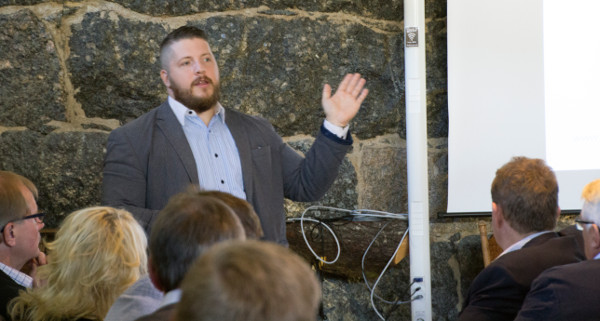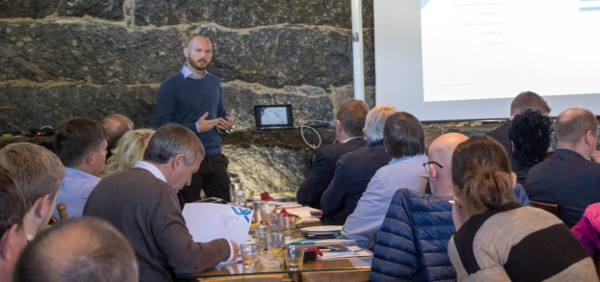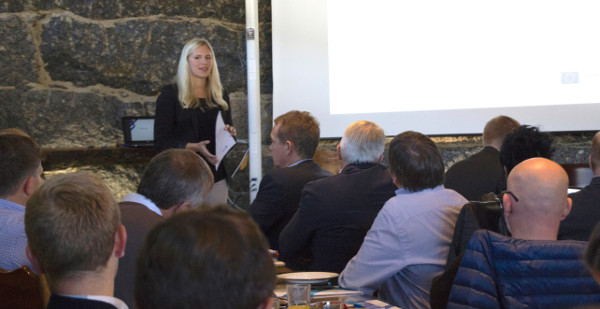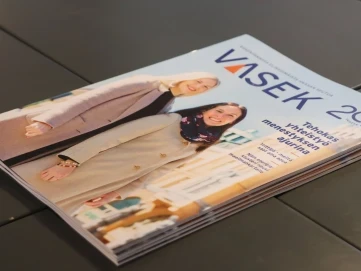E12 Project Continues the Development of Cross-Border Transport Route and Cooperation
The E12 project got off to a flying start in spring 2016 when the cooperation partners organized the Kvarken Motorways of the Sea conference in Umeå and Vaasa. In mid-September, the project implementers and partners gathered in Vaasa for a GetTogether seminar, revising the project’s implementation and schedules. The project is set to be completed in May 2018.

Mathias Lindström
The cross-border E12 Atlantica Transport project between project partners in Finland, Sweden and Norway aims to strengthen the cooperation between the partners, reduce border barriers, and develop the transport route ranging from the Norwegian Helgeland across the Swedish Västerbotten and all the way to the Finnish Ostrobothnia. The project, which was launched in the beginning of the year and receives EU-funding via the Botnia-Atlantica programme, continues the successful work of the previous cooperation projects.
The E12 project got off to a flying start in spring 2016 when the cooperation partners organized the Kvarken Motorways of the Sea conference in Umeå and Vaasa. In mid-September, the project implementers and partners gathered in Vaasa for a GetTogether seminar, revising the project’s implementation and schedules. The project is set to be completed in May 2018.
Closer Cooperation
 Andreas Forsgren
Andreas Forsgren
Mr Mathias Lindström, Director of the Kvarken Council, described to the participants the type of cross-border cooperation that has been made for the development of the E12 route for decades. This cooperation is unique at a European level and will continue. In order to develop a better and more versatile transport route, the region needs joint strategies, better utilization of knowledge and know-how, and strong commitment to increasingly closer cooperation.
“The preservation of the E12 route as part of an EU-comprehensive network is incredibly important for this region, and we must work constantly in order to secure it. This necessitates regional consensus, unanimity between the project implementers, and strong commitment from national decision-makers,” Lindström highlights.
The project implementers are aware of the fact that cooperation will result in better results and better prerequisities for new investments and for utilizing the infrastructure investments already completed in the region.
”We will, by means of closer collaboration and efficient use of infrastructure, facilitate the transport of goods to the markets of more populous regions on the Continent, create more jobs and increase the competitiveness of our region and, in this way, also its wellbeing”, says Mr. Andreas Forsgren, Infrastructure Strategist of the Municipality of Umeå and member of the project management team.
Different Work Packages
 Anna Måtts-Fransén
Anna Måtts-Fransén
The project aims to reduce border barriers along the E12 route, strengthen the region’s competitiveness, create a solid foundation for future infrastructure investments, achieve stronger cooperation with the economic life, and produce high-quality materials to serve as the basis of infrastructure and transport decisions. In order to achieve all this, the project has been divided into three different work packages that complement each other.
The first package, “A Functional Transport Route” aims to identify possibilities to further optimize and develop east-west transport solutions. The second, “Cross-Border Strategies”, attempts to develop cross-border collaboration structures that enable joint traffic strategies and cross-border infrastructure planning. The last, “Future Cooperation Structures”, focuses on the outlining of future cooperation structures. Each work package has its own leader, workgroup and clear implementation plan.
An important part of the project is the system analysis due to be completed next March. The system analysis analyzes project-related infrastructure and reviews the traffic’s current and target situations. At the same time, it aims to find out how to best achieve the project’s objectives.
”The system analysis will serve as a basis for a joint transport strategy. If we can achieve a joint transport strategy, we will be pioneers in Europe”, Mr. Forsgren adds.
Moreover, a Transport Management System Study, which aims to create a convenient digital documentation system that will be tested in the cargo transports along the E12 route, is underway. It is based on cellphones and the utilization of optical codes, and its objective is to create an open system that provides information about the cargo transport for all the concerned parties in the process. Both abovementioned examples are part of the first work package.
“We’re also seeking information and experiences and highlight the visibility of our region by participating in national and international business-related events and by organizing study trips and events that will draw private and public sectors representatives and researchers,” tells Ms Anna Måtts-Fransén, Logistics Specialist at VASEK (Vaasa Region Development Company) and member of the project management.
“The Motorways of the Sea event, which was organized in the spring, is a good example of such activities.
[contact_member,name=Anna Måtts-Fransén,id=16,details=Name]

